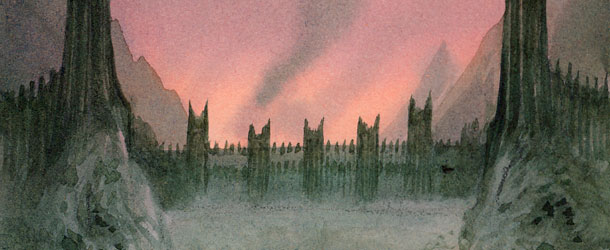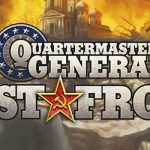Among the rules of War of the Ring, there was a little one which was apparently almost negligible when we first put it on the paper, but over time became the central point of one of the “Ace up the sleeve”-like strategies of the Shadow player – how the Fellowship enters Mordor.
In first edition, players found a way to exploit the rule which requires the Fellowship to come onto the gates of Mordor hidden, before it is able to start its path inside the Black Land: the so-called “turn stalling”. Certain event cards (such as “Orc Patrol” and “Nazgul Search”) were almost never used “normally”, but always timed in such a way that entering Mordor was delayed by one full turn. Thanks to the card-drawing ability of the Witch-king, that we discussed in part 7, the Shadow player would “dig” into the Character Event deck, then throw them onto the Fellowship at the right moment, gaining one turn at least for the Shadow military onslaught.
This strategy was very “gamey” in our opinion, and one of the unexpected unbalancing factors which had surfaced through extensive play of our design, and was something we wanted to solve with Second Edition.
While apparently simple, this change provoked a lot of discussion. Initially, we wanted to tackle it modifying the Event cards which had a bad interaction with this rule, but in the end the cards were nerfed so badly that they were perceived as almost useless.
In the end, the solution at hand was more simple and balanced – the Fellowship could be revealed in Morannon or Minas Morgul and still enter Mordor, but before starting on the Mordor Track, it must be hidden again. The last part of the Quest of the Ringbearers, with this change, was just slightly easier to reach than before. This gave a small nudge in the direction of making the life of the Free Peoples player less rough - which was our intention with the revision of the game – and also simplified the rule a little, what else to ask?
Other rules changes of minor impact were applied here and there (such as a streamlining of small and bothersome differences between different rules which involved Strongholds and their control)... At last, even when rules changes were finalized, the discussion was not over yet, because we realized that when certain rules had a need to be made clear, but (almost in a way reminiscent of Quantum Mechanics!) trying to rewrite them for clarity almost always changed them.
The one area of the rules which received the deepest review from a “formal” point of view was the Hunt. On the surface, the Hunt is a simple affair – you roll dice, if there is a success you draw a tile, look at the tile and apply the effect. Right? No, really. On the Hunt, there are a lot of different elements which can modify this simple scenario. The ability of the Guide of the Fellowship. The effect of play-on-the-table cards. The regions where the Fellowship moves. If the Hunt was provoked by an Event card, the text of that card. Over time, it was clear that the interaction of these effects was absolutely not easy to handle and it generated a LOT of questions in the FAQ of the original game. Was there a way to swipe all of those questions away? Once again, it was our “dog of war”, Kevin “Krieghund” Chapman, who spurred us to go in depth on this topic, and the result was a complete rewriting of the Hunt rules, which in the end should (we hope) clarify most of those issues. After that, it was essentially over. Time was short, if we wanted the game to be on the shelves for Christmas time. Our new publisher, Ares Games, wanted us to complete the work , and so we did.
Post Scriptum
As all things come to an end, so did our playtesting – and our series of articles. Even in such a long series of articles as this one, it’s difficult to re-tell everything that happened over months of discussion, hundreds of games, thousands of e-mails shared.
The discussion which went on during the playtesting covered many more topics than those discussed in these articles, as from time to time almost every element of the game became a subject of discussion.
Now, the great thing of a playtesting with people who have such a great experience with the game that we designed, is that they come up all the time with novel ideas – and that unfortunately, as in the nature of a playtesting, these ideas more often than not must be discarded.
We believe that War of the Ring Second Edition improves the balance and clarifies a lot of the more foggy areas of the original edition of the game. Now, it will be up to the players, new and old, to judge the quality of our efforts.
As our last words, a big “thank you” to everybody who, buying and playing the first edition of the game, made it a success and made this Second Edition possible. And thanks to everybody who, asking questions and clarifications, made it possible to improve the quality of the rules and cards in the game. But of course, the greatest thanks must go to all the friends who have been helping us during the playtest, both of the first edition and the second, and that you find credited in the last pages of the rules – here they are again:
Contributing Playtesters – the people who helped us the most when we designed the first edition, through dedicated testing and suggestions… and some of them continued to do so with the second edition as well! Doug Adams, Kristofer Bengtsson, Kevin Chapman, Derek Coon, Andy Daglish, Caleb Diffell, Ugo Di Meglio, David Fristrom, Sergio Guerri, Kris Hall, Michael Hall, Mike Helba, Steve Hope, Christian Hrdlicka, Sean McCarthy, Marco Molin, Don Moody, Paolo Morescalchi, Steve Owen, Christian Petersen, Dan Raspler, Alex Rockwell, Steve Sanders, Douglas Silfen, Matthias Staber, Marcello Taglioli, Renaud Verlaque.
Revised Edition Playtesters – our most active second edition playtester: Amado Angulo, Melanie Chapman, David Fortner, Tom Hanks, Peter Majek, David Morse, Luigi Pioto, Andrew Poulter, Ralf Schemmann, Glenn ‘Magic Geek’ Shanley, Alija Villa, Wes Wagner, Kevin Warrender, Kevin Wojtaszczyk, Chris Young.
Plus… well-deserved special thanks to Kristofer Bengtsson and Kevin Chapman for their continuous support to the clarification of the War of the Ring rules and their precious feedback (as you have read in these articles, they are REALLY well deserved!).
And... an additional “thank you” specifically to Sean McCarthy and Andrew Poulter who, with their efforts in creating and developing the War of the Ring online client, made the playtesting possible.










